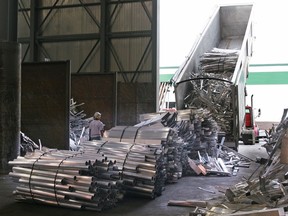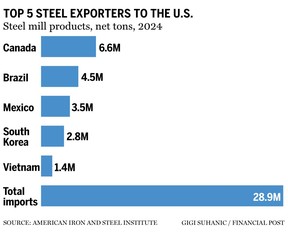Sector insiders are hoping to draw on past experience to better navigate the crisis

Article content
United States President Donald Trump is set to announce 25 per cent tariffs on aluminum and steel imports from all countries, replicating a policy move he used in his first term against Canada with mixed results.
Article content
Article content
Now, insiders in those sectors are hoping to draw on past experience to formulate a more effective counter response if Trump ignites another trade war with them.
Advertisement 2
Article content
“If we can’t get out of the tariffs, we need to hit back hard,” said Catherine Cobden, president of the Canadian Steel Producers Association, whose members produce around 23 million tonnes of steel per year and employ 13,000 people.
Exactly how to hit back depends on how Trump invokes tariffs. As of Monday morning, Cobden and others were still guessing about that.
Regardless, she predicted tariffs on Canadian steel would lead to inflation, both in the U.S., where the 25 per cent tariffs would be applied, and also in Canada because of the tight integration of the two markets.
Cobden also said the tariffs could quickly lead to curtailed production at Canadian steel plants, followed by job losses.
Both the steel and aluminum sectors in Canada are highly dependent on the U.S. export market, and insiders are still holding out hope that tariffs and a trade war can be averted.
But with that possibility looking less and less likely as Trump repeatedly lashes out at Canada over multiple issues, sector insiders are hoping to draw on past experience to better navigate the crisis.
Article content
Advertisement 3
Article content
During his first term, Trump imposed 10 per cent tariffs on aluminum and 25 per cent tariffs on steel in June 2018, citing national security reasons. The following month, Canada announced similar countermeasures on U.S. steel and aluminum imports.
Both countries lifted their tariffs in May 2019, but a little more than one year later, after months of speculation and discussion, Trump reimposed 10 per cent tariffs on Canadian aluminum in August 2020.
That second bout lasted only a month, however. In September, as Trump’s re-election campaign entered full swing, he agreed to drop the tariffs and instead impose import quotas after a period of study. In the end, he lost the election before the study finished, and president Joe Biden dropped the policy.
Canada never imposed its planned retaliatory measures, which at the time were said to be tailored to restrict trade on washing machines and other products manufactured in critical political battlegrounds for Trump.
The U.S. continues to rely on Canada for most of its aluminum. In 2023, it imported 3.1 million tonnes of aluminum from Canadian producers, which represented more than 80 per cent of Canada’s total production.
Advertisement 4
Article content

Philippe Pourreaux, a partner at consultancy firm PricewaterhouseCoopers Canada, said imposing tariffs on steel and aluminum did not stir investment in U.S. steel and aluminum manufacturing when Trump tried it last time.
“If we look at the (production) footprint today, there’s not been a significant change to the footprint,” he said. “It hasn’t yielded those long-term benefits of bringing primary steel and aluminum production back into the U.S.”
U.S. primary aluminum production did increase in 2018 and 2019 — the main period when Trump imposed tariffs — by as much as 20 per cent and 22 per cent, respectively, according to Statista data. But production has tapered off since then, and even aluminum groups in the U.S. say they need Canadian aluminum and called for an exemption from tariffs.
“It would take billions of investment over decades to make the United States fully self-sufficient for its metal needs,” the Aluminum Association, a U.S.-based trade group, said in a statement on Feb. 1.
One Canadian aluminum industry insider, who requested anonymity because the tariffs were still under consideration, said the U.S. cannot offset its aluminum imports through domestic production.
Advertisement 5
Article content
“It’s all about energy,” they said. “You can’t replace what’s coming in without the energy that’s required and they don’t have that energy. We’re basically shipping energy in the form of aluminum.”
Unlike Canada, where aluminum smelters are based in the hydroelectric-rich provinces of Quebec and British Columbia, the U.S. has four smelters, three of which rely on grids that are powered by coal, or coal in conjunction with natural gas, according to Annie Sartor, campaign director for aluminum at Industrious Labs, an advocacy group focused on industrial decarbonization.
She pointed out that the U.S. Department of Energy in January awarded US$500 million through the Inflation Reduction Act to Chicago-based Century Aluminum Co. to build the country’s first “green” smelter because it is expected to rely on low-emissions electricity. If built, it would mark the first new smelter in the country in 45 years.
Recommended from Editorial
But the plant would not be able to offset the U.S. demand for aluminum imports even if it is completed and begins production as expected, around the end of the decade, Sartor said.
“We’ll still be very reliant on imports,” she said.
• Email: gfriedman@postmedia.com
Bookmark our website and support our journalism: Don’t miss the business news you need to know — add financialpost.com to your bookmarks and sign up for our newsletters here.
Article content


